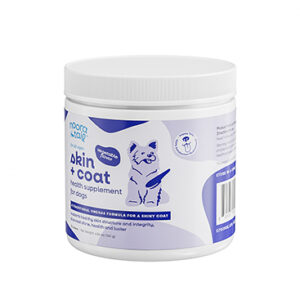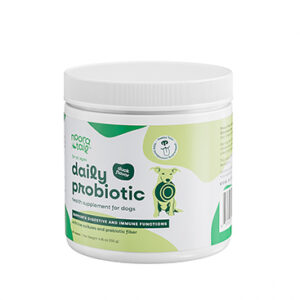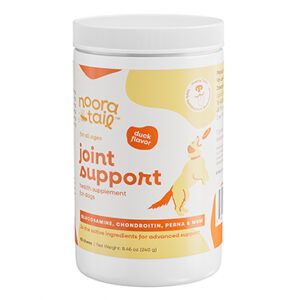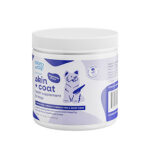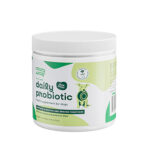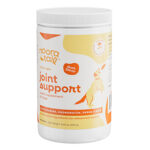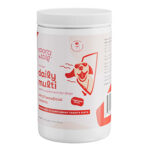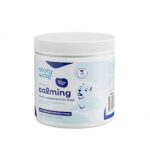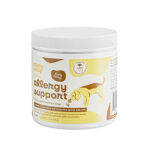Anti-Allergy Dog Considerations

If you’re allergic to dogs but still long for the companionship of a furry friend, you’re not alone. Many people think they can’t have a dog because of their allergies, but there are actually several breeds that are considered “anti-allergy.”
What Causes Dog Allergies?
Dog allergies are caused by proteins in the dog’s saliva, urine, and dander. Dander is the shed skin cells that dogs lose continuously. When these proteins are released into the air, they can be inhaled by people, triggering an allergic reaction.
Symptoms of Dog Allergies
Symptoms of dog allergies can include:
- Sneezing
- Runny or itchy nose
- Watery or itchy eyes
- Coughing
- Wheezing
- Shortness of breath
- Skin rashes
Anti-Allergy Dog Breeds
Not all dogs are created equal when it comes to allergies. Some breeds produce more of the allergenic proteins than others. The following breeds are known for being low-allergen:
- Poodle (Standard, Miniature, and Toy): Poodles have a single-layer coat that sheds very little. They also produce less of the allergenic protein in their saliva.
- Bichon Frise: Bichons have a soft, curly coat that is also low-shedding. They are also known for their hypoallergenic qualities.
- Schnauzer (Standard, Miniature, and Giant): Schnauzers have a wiry coat that is low-shedding and non-allergenic.
- Irish Water Spaniel: Irish Water Spaniels have a dense, curly coat that sheds very little. They are also very friendly and playful dogs.
- Portuguese Water Dog: Portuguese Water Dogs have a single-layer coat that is also low-shedding. They are highly intelligent and trainable dogs.
Other Considerations
Even if you choose an anti-allergy dog breed, there are still some things you can do to reduce your risk of an allergic reaction:
- Brush your dog regularly: Brushing helps to remove loose hair and dander from your dog’s coat.
- Bathe your dog every 2-3 weeks: Bathing can help to remove allergens from your dog’s skin and coat.
- Keep your home clean: Vacuum and dust regularly to remove dog hair and dander.
- Use a HEPA filter: HEPA filters can help to remove allergens from the air.
- Avoid contact with your dog’s saliva: Don’t allow your dog to lick your face or hands.
Conclusion
If you’re allergic to dogs but still want to have a furry companion, there are several anti-allergy dog breeds that you can consider. By taking the necessary precautions, you can reduce your risk of an allergic reaction and enjoy the companionship of a dog.
Hypoallergenic Breeds:
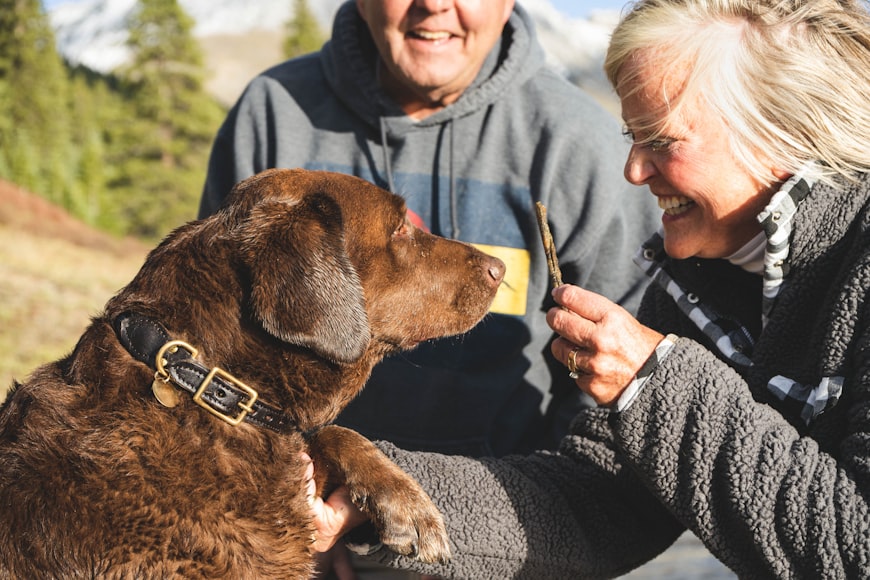
For individuals with allergies, the dream of canine companionship can often seem out of reach. But fear not, because hypoallergenic breeds offer a ray of hope, providing the joy of pet ownership without the discomfort of allergic reactions. Here’s a detailed guide to five hypoallergenic dog breeds that will bring love and happiness into your life without triggering allergies:
1. Poodle
- Hypoallergenic: Yes, in all sizes (Toy, Miniature, Standard)
- Characteristics: Intelligent, playful, and affectionate
- Grooming: Requires regular brushing and professional grooming to maintain a low-shedding coat
2. Bichon Frise
- Hypoallergenic: Yes
- Characteristics: Cheerful, lively, and hypoallergenic
- Grooming: Daily brushing to prevent mats and tangles, professional grooming every 6-8 weeks
3. Maltese
- Hypoallergenic: Yes
- Characteristics: Gentle, playful, and devoted
- Grooming: Daily brushing to prevent tangles, professional grooming every 6-8 weeks
4. Shih Tzu
- Hypoallergenic: Yes
- Characteristics: Playful, affectionate, and loyal
- Grooming: Daily brushing and regular professional grooming to prevent matting
5. Yorkshire Terrier
- Hypoallergenic: Yes
- Characteristics: Playful, feisty, and affectionate
- Grooming: Daily brushing to prevent tangles, professional grooming every 6-8 weeks
Benefits of Choosing a Hypoallergenic Dog
- Reduced Allergy Symptoms: These breeds produce minimal dander and saliva, which are the primary allergy triggers.
- Improved Quality of Life: Allergy sufferers can enjoy the benefits of pet ownership without the discomfort of symptoms.
- Affection and Companionship: Hypoallergenic dogs provide unconditional love and companionship, enriching your life.
- Low Maintenance: While regular grooming is essential, hypoallergenic breeds shed less, making them easier to care for.
Tips for Choosing a Hypoallergenic Dog
- Talk to a veterinarian: Seek professional advice to determine if a hypoallergenic breed is right for you.
- Meet the breed: Spend time with potential breeds to assess their personality and temperament.
- Consider size and grooming needs: Choose a breed that aligns with your lifestyle and ability to groom.
- Be prepared for regular grooming: Hypoallergenic breeds require consistent grooming to maintain their low-shedding coat.
Remember:
- No dog is 100% hypoallergenic.
- Allergies vary in severity from person to person.
- Introduce the dog to your home gradually to monitor any allergic reactions.
Conclusion
Hypoallergenic dogs offer a wonderful opportunity for individuals with allergies to experience the joy of companionship without the debilitating effects of allergens. With their playful personalities, affectionate nature, and low-shedding coats, these breeds will bring love and happiness into your life without triggering unwanted reactions. Embrace the joy of canine ownership today with a hypoallergenic dog that will forever be your loyal and loving companion.
Coat Type:

Allergies to dogs can be a common challenge for pet lovers. However, with the right breed choice, it’s possible to enjoy the companionship of a furry friend without the discomfort of allergic reactions. Anti-allergy dogs are typically characterized by their hypoallergenic coat type, which includes curly or non-shedding fur.
Understanding Dog Allergies
Dog allergies are primarily caused by proteins found in a dog’s dander (skin flakes), saliva, and urine. When these proteins come into contact with a person’s immune system, it may trigger an allergic response characterized by symptoms such as sneezing, runny nose, watery eyes, and itchy skin.
Curly Coated Breeds
Curly coated breeds are hypoallergenic because their hair follicles grow in tight curls, preventing the release of dander and saliva into the air. These breeds shed very little, making them a good choice for individuals with allergies.
- Poodle: Poodles come in three sizes (toy, miniature, and standard) and are known for their intelligence, athleticism, and hypoallergenic coat.
- Bichon Frise: Bichons have a fluffy, white curly coat that is non-shedding and hypoallergenic. They are cheerful and affectionate companions.
- Lagotto Romagnolo: This Italian breed has a dense, tightly curled coat that is hypoallergenic and water-resistant. They are energetic and eager to please.
Non-Shedding or Low-Shedding Breeds
Non-shedding or low-shedding breeds have a single coat that does not shed seasonally like double-coated breeds. This minimizes the release of dander and saliva into the air, reducing the risk of allergic reactions.
- Schnauzer: Schnauzers come in three sizes (miniature, standard, and giant) and have a wiry, non-shedding coat. They are intelligent and devoted companions.
- Yorkshire Terrier: Yorkies have a long, silky coat that does not shed much. They are small and feisty, making them popular lapdogs.
- ** Maltese:** Maltese have a flowing white coat that is hypoallergenic and non-shedding. They are gentle and affectionate companions.
Additional Tips for Reducing Dog Allergies
While certain breeds are considered hypoallergenic, it’s important to note that no dog is 100% allergy-free. However, there are additional steps you can take to minimize allergic reactions:
- Regular grooming: Brushing your dog regularly can help remove loose hair and dander.
- Bathing: Bathing your dog every 1-2 weeks can further reduce the amount of dander and saliva on its coat.
- Vacuuming and cleaning: Vacuuming and cleaning frequently helps to remove dog hair and dander from the home environment.
- HEPA filters: Using HEPA filters in air purifiers can trap dog allergens in the air.
Conclusion
Anti-allergy dogs with curly or non-shedding coats can provide a hypoallergenic option for individuals with allergies. By choosing the right breed and following proper grooming and cleaning techniques, it’s possible to enjoy the companionship of a furry friend without the discomfort of allergic reactions. Remember to consult with a veterinarian or allergist before bringing a new dog into your home to determine the best breed for your individual needs.
Dander Control:

As a dog lover and pet blogger, I understand the joy and unconditional affection that furry companions bring to our lives. However, for those with allergies, the thought of sharing their home with a canine friend can be daunting. Thankfully, with the right care and precautions, it is possible to enjoy the companionship of a dog without compromising your well-being. This article will delve into the essential strategies for dander control, empowering you to create an allergy-friendly environment for your cherished pet.
Understanding Dander and Allergies
Animal dander, composed of microscopic skin flakes and saliva, is the primary trigger for pet allergies. When these particles are inhaled, they can cause unpleasant reactions such as sneezing, runny nose, itchy eyes, and difficulty breathing. Dander production varies among breeds, with some being more likely to provoke allergic responses than others.
Best Practices for Dander Control
1. Regular Bathing and Brushing:
Regular bathing and brushing are crucial for minimizing dander build-up on your dog’s skin and fur. Use lukewarm water and a mild, hypoallergenic shampoo specifically designed for dogs with allergies. Brush your dog thoroughly before and after bathing to remove loose hair and dander.
2. Anti-Dander Shampoo and Conditioner:
Invest in anti-dander shampoo and conditioner to specifically target and reduce dander production. These products contain ingredients like oatmeal, aloe vera, and tea tree oil, which soothe the skin, reduce inflammation, and minimize shedding.
3. Environmental Modifications:
Create a dander-free zone in your home by eliminating possible allergen sources. Use an air purifier with a HEPA filter to trap airborne particles. Vacuum carpets and upholstery regularly using a vacuum cleaner with a HEPA filter and consider hard flooring over rugs.
4. Limiting Exposure:
Keep your dog out of bedrooms and other areas where you spend extended periods of time. This limits direct exposure to dander and reduces the likelihood of allergic reactions.
5. Hypoallergenic Dog Breeds:
Consider adopting a hypoallergenic dog breed that sheds less and produces lower levels of dander. Breeds such as Poodles, Bichons Frises, Maltese, and Schnauzers are often recommended for allergy sufferers.
6. Medication and Immunotherapy:
If necessary, consult with an allergist to discuss medication options such as antihistamines or nasal sprays. Immunotherapy, a desensitization process, can also be an effective long-term treatment for pet allergies.
Additional Tips for Allergy Sufferers:
- Avoid petting your dog directly on the face or licking.
- Wash your hands after handling or grooming your dog.
- Change your bed sheets and pillowcases frequently.
- Consider using a face mask when vacuuming or cleaning areas where your dog has been present.
- Talk to your veterinarian about any additional measures or medications that may be appropriate for your specific situation.
Conclusion
By following these comprehensive dander control strategies, you can significantly reduce the presence of allergens in your home and enjoy the companionship of your beloved dog. Remember, open and honest communication with your veterinarian is essential for tailoring an allergy-friendly plan that meets your individual needs. With the right care and precautions, you can create a harmonious living environment where both you and your furry friend can thrive.
Grooming:

As a pet blogger specializing in dogs, you often encounter queries related to pet care, especially for those suffering from allergies. Anti-allergy dogs, while not completely hypoallergenic, produce lower levels of the allergens that trigger reactions in sensitive individuals. Proper grooming is essential to minimize these allergens and maintain a healthy living environment for both pet and owner.
Understanding Anti-Allergy Dogs
Anti-allergy dogs possess specific characteristics that make them less allergenic than other breeds. These include:
- Low-Shedding Coat: These dogs shed very little hair, reducing the amount of dander in the air.
- Non-Drooling: They produce less saliva, which contains allergens that can trigger reactions.
- Single-Layered Coat: Their coats have a single layer of hair, unlike double-coated breeds that tend to shed more.
Grooming Regimen for Anti-Allergy Dogs
To effectively control allergens and maintain a healthy coat, anti-allergy dogs require regular grooming. Here’s a comprehensive guide:
1. Professional Grooming Every 6-8 Weeks:
Professional groomers are equipped with specialized tools and techniques to effectively remove loose hair, dander, and allergens from your dog’s coat. They will thoroughly brush, bathe, and blow-dry your pet, leaving them clean and allergen-free. This routine should be performed every 6-8 weeks to ensure optimal allergen reduction.
2. Trim/Shave Excess Hair Regularly:
Anti-allergy dogs with longer hair may require more frequent trimming or shaving to minimize shedding. Regular grooming will prevent hair from accumulating and releasing allergens into the environment. Consult with your groomer to determine the appropriate length and frequency for your dog’s specific breed and coat type.
3. Bathing with Hypoallergenic Shampoo:
Use only hypoallergenic shampoos specifically designed for anti-allergy dogs. These shampoos are fragrance-free, dye-free, and contain gentle ingredients that won’t irritate your pet’s skin. Bathe your dog every 2-3 weeks to remove allergens and keep their coat clean.
4. Brushing Regularly:
Regular brushing helps remove loose hair, dander, and allergens from your dog’s coat. Brush your pet at least twice a week, using a soft-bristled brush or a rubber grooming mitt. This will distribute natural oils throughout the coat, keeping it healthy and free of debris.
5. Nail Care and Ear Cleaning:
While nail care and ear cleaning don’t directly impact allergies, they are essential for your dog’s overall health and well-being. Trim your dog’s nails regularly and clean their ears with a cotton ball dipped in a pet-friendly ear cleaner.
6. Vacuuming and Air Filtering:
Vacuum your home frequently, especially areas where your dog spends time. This will remove allergens from carpets and furniture. Consider using an air purifier with a HEPA filter to trap allergens in the air.
Additional Tips
- Avoid using harsh chemicals or scented products on your dog’s coat.
- Keep your dog off your bed and out of your bedroom to minimize allergen exposure during sleep.
- Wash your dog’s bedding frequently in hot water.
- Use a lint roller to remove any remaining allergens from clothing and furniture.
Conclusion
Proper grooming is a crucial component of owning an anti-allergy dog. By following these comprehensive grooming practices, you can effectively reduce allergens in your environment and ensure a healthy and comfortable living space for both you and your furry companion. Remember, consistency and a veterinarian’s guidance are key to maintaining your dog’s hypoallergenic nature and promoting a harmonious home for all.
Environment Management:
As a dog lover living with allergies, understanding and managing your home environment is crucial for a comfortable and healthy coexistence with your furry companion. Here are six essential steps for creating an allergy-friendly living space:
1. Frequent Vacuuming and Mopping
Pets shed dander, which is a major allergen. Vacuuming and mopping your floors regularly removes dander and other allergens from carpets, furniture, and surfaces. Use a high-efficiency vacuum cleaner with a HEPA filter to trap microscopic particles effectively.
2. HEPA Filters in HVAC System
High-efficiency particulate air (HEPA) filters are essential for reducing indoor air pollution. Install HEPA filters in your HVAC system to capture allergens, dust mites, and other irritants. Replace filters regularly to maintain their effectiveness.
3. Remove Carpets and Rugs
Carpets and rugs trap dander and dust mites, making them a breeding ground for allergens. If possible, remove carpets and rugs from your home, especially in bedrooms and areas where your dog spends a lot of time.
4. Bare or Hard Surface Floors
Opt for flooring that is easy to clean, such as tile, laminate, or hardwood. These surfaces prevent dander and dust from accumulating and are much easier to maintain.
5. Use Air Purifiers
Air purifiers can be a valuable addition to your allergy-fighting arsenal. Look for purifiers equipped with HEPA filters to capture airborne allergens and improve overall indoor air quality.
6. Wash Bedding and Curtains Regularly
Pet dander clings to bedding and curtains. Wash these items weekly in hot water and use hypoallergenic detergents. Avoid using fabric softeners, as they can irritate sensitive skin.
Additional Tips:
- Keep your dog well-groomed by brushing and bathing them regularly.
- Use a lint roller to remove pet hair from clothing and furniture.
- Consider using anti-allergy pet wipes or sprays to minimize dander on your dog’s coat.
- Create pet-free zones in your home, such as your bedroom, to provide a safe haven from allergens.
- Avoid smoking indoors, as secondhand smoke can worsen allergies.
By implementing these environmental management strategies, you can significantly reduce the number of allergens in your home, making it a more comfortable and enjoyable living space for both you and your beloved dog. Remember to consult with an allergist for personalized recommendations and medical guidance.
Indoor Air Quality:
As a dog lover, sharing your life with a furry companion brings endless joy. However, for those with allergies, the presence of a dog can trigger uncomfortable symptoms such as sneezing, itchy eyes, and skin irritation. Indoor air quality plays a crucial role in managing these allergies, and by taking proactive measures, you can create a comfortable and healthy living space for both you and your beloved pup.
Understanding Allergens
Dog allergies are primarily caused by allergens present in the animal’s saliva, dander (shed skin cells), and urine. These allergens are microscopic particles that can easily become airborne and circulate throughout your home. Exposure to these allergens triggers an allergic reaction in susceptible individuals.
Improving Indoor Air Quality
To reduce the impact of dog allergens on your indoor air quality, it is essential to implement the following strategies:
1. Keep Humidity Levels Low
High humidity levels create an ideal environment for mold and dust mites, both of which can exacerbate allergies. Maintaining low humidity levels (between 30-50%) helps control the growth of these allergy-causing agents. Use a dehumidifier to remove excess moisture from the air, especially during humid seasons.
2. Use Air Purifiers to Remove Allergens
Air purifiers equipped with HEPA (High-Efficiency Particulate Air) filters can effectively remove allergens from the air. These filters are designed to trap particles as small as 0.3 microns, including dog dander and other allergens. Choose an air purifier with a high CFM (cubic feet per minute) rating, which indicates its air filtration capacity.
3. Regular Cleaning and Vacuuming
Regular cleaning and vacuuming are crucial for removing pet hair, dander, and other allergens from surfaces. Use a vacuum cleaner with a HEPA filter to trap allergens during the cleaning process. Vacuum high-traffic areas frequently and pay special attention to upholstered furniture, carpets, and bedding.
4. Wash Bedding and Fabrics
Dog allergens can accumulate on bedding and fabrics, so it is important to wash these items regularly. Use hot water and a detergent specifically designed for pet owners. Consider using hypoallergenic bedding to further reduce allergen exposure.
5. Limit Pet Access to Certain Areas
If you are severely allergic, restricting your dog’s access to certain areas of the house, such as your bedroom or office, can help reduce your exposure to allergens. Use baby gates or other barriers to limit your dog’s movements.
6. Consider Anti-Allergy Dog Breeds
Certain dog breeds are considered hypoallergenic, meaning they produce fewer allergens. These breeds include the Poodle, Shih Tzu, Maltese, Bichon Frise, and Havanese. While no dog is truly hypoallergenic, these breeds can significantly reduce allergen levels in the home.
7. Seek Professional Advice
If your allergies persist despite implementing these measures, consider consulting a healthcare professional. They can perform allergy testing to confirm which allergens are causing your symptoms and recommend personalized treatment options.
Conclusion
Managing indoor air quality is essential for dog lovers with allergies. By reducing allergen levels and maintaining a healthy living environment, you can enjoy the companionship of your furry friend without sacrificing your well-being. Implementing these strategies will create a more comfortable and healthy home for both you and your dog. Remember, with proper care and a few simple adjustments, pet ownership can be a rewarding and allergy-friendly experience.
Other Considerations:
For people who suffer from pet allergies, finding a furry companion can seem like an impossible dream. Fortunately, there are certain breeds that are considered “hypoallergenic” or “anti-allergy,” meaning they produce fewer allergens that trigger allergic reactions.
Understanding Pet Allergies
Pet allergies are caused by proteins found in animal saliva, dander, and urine. These proteins are released into the air, particularly when the animal sheds or grooms itself. When an allergic individual inhales these allergens, their immune system overreacts, releasing histamines and causing symptoms such as sneezing, watery eyes, runny nose, and difficulty breathing.
Anti-Allergy Dog Breeds
While no dog breed is completely allergen-free, the following breeds are known to be less allergenic than others:
- Poodles (Standard, Miniature, Toy)
- Bichon Frise
- Shih Tzu
- Yorkshire Terrier
- Maltese
- Havanese
- Goldendoodle
- Labradoodle
- Schnauzer (Miniature, Standard)
These breeds tend to have non-shedding or hypoallergenic coats, produce less dander, and have low levels of the specific proteins that trigger allergies.
Other Considerations for Preventing Allergies
In addition to choosing an anti-allergy dog breed, there are other measures you can take to reduce allergens in your home and minimize allergic reactions:
- Regular Bathing and Grooming: Regular bathing and brushing removes loose hair and dander.
- Use a HEPA Filter: HEPA filters capture airborne allergens, including pet dander.
- Vacuum Regularly: Vacuuming carpets, furniture, and other surfaces removes allergens from circulation.
- Avoid Heavy Perfumes or Scented Products: Strong scents can irritate allergies, so avoid using heavily scented products in your home.
- Keep Dogs Out of Bedrooms and Off Furniture: Restricting dogs to certain areas of the house reduces their exposure to allergens.
- Consider Allergy Medication: If necessary, consult with your doctor about allergy medications that can help reduce symptoms.
Managing Allergies with Anti-Allergy Dogs
While anti-allergy dog breeds can significantly reduce allergens, it’s important to manage your allergies carefully. Here are some tips:
- Get a professional allergy test to confirm the specific allergens you are allergic to.
- Spend time with the dog before bringing it home to see how your allergies react.
- Be patient and consistent with your allergy management routine.
- Don’t give up if you experience initial symptoms; it may take time for your allergies to adjust.
Conclusion
For people with pet allergies, anti-allergy dogs offer the possibility of owning a furry companion without the discomfort of allergic reactions. By choosing the right breed and following proper allergy management strategies, you can enjoy the love and companionship of a dog without sacrificing your health. Remember to consult with a healthcare professional if your allergies are severe or do not improve with these measures.
Medical Management:
Allergies are a common and frustrating problem for many dog owners. They can cause a wide range of symptoms, from mild itching to severe breathing difficulties. While there is no cure for allergies, there are a number of ways to manage them and improve your dog’s quality of life.
Diagnosis
The first step in managing allergies is to identify the specific triggers that are causing your dog’s symptoms. This can be done through allergy testing, which involves exposing your dog to a panel of common allergens and then measuring their immune response.
Once the triggers have been identified, your veterinarian can develop a treatment plan to help your dog avoid them. This may involve changes to your dog’s diet, lifestyle, or environment.
Medications
In some cases, medications may be necessary to control your dog’s allergy symptoms. These medications can include:
- Antihistamines: These medications block the histamines that are released by the body in response to an allergic reaction. Histamines cause inflammation and swelling, so antihistamines can help to reduce these symptoms.
- Corticosteroids: These medications are more powerful than antihistamines and can be used to treat more severe allergic reactions. Corticosteroids reduce inflammation and swelling, and they can also suppress the immune system.
Other Treatments
In addition to medications, there are a number of other treatments that can help to manage allergies in dogs. These treatments include:
- Dietary changes: Eliminating certain foods from your dog’s diet can help to reduce their exposure to allergens. Common allergens in dogs include beef, chicken, wheat, and corn.
- Lifestyle changes: Avoiding exposure to allergens can help to reduce your dog’s symptoms. This may involve keeping your dog away from certain plants, animals, or environments.
- Environmental control: Using air purifiers, humidifiers, and dehumidifiers can help to reduce the amount of allergens in your home.
Prognosis
The prognosis for dogs with allergies varies depending on the severity of their symptoms and how well their condition is managed. With proper treatment, most dogs with allergies can live long, healthy lives.
If you think your dog may have allergies, it is important to see your veterinarian for a diagnosis and treatment plan.
Diet:
Allergies are a common ailment in dogs, and they can cause a range of uncomfortable symptoms, including itchy skin, runny eyes, and respiratory problems. While there is no cure for allergies, there are a number of things you can do to manage your dog’s symptoms, including avoiding foods that cause allergies and feeding them a hypoallergenic diet.
What is a hypoallergenic diet?
A hypoallergenic diet is a diet that contains very few ingredients, all of which are unlikely to cause an allergic reaction. This type of diet can be helpful for dogs with allergies because it reduces their exposure to potential allergens.
There are two main types of hypoallergenic diets:
- Elimination diets involve feeding your dog a very limited diet of a single protein source and a single carbohydrate source for 8 to 12 weeks. If your dog’s symptoms improve on this diet, you can then start adding new ingredients back into their diet one at a time to see which ones they are allergic to.
- Hydrolyzed protein diets contain proteins that have been broken down into such small pieces that the body cannot recognize them as allergens. This type of diet is more expensive than elimination diets, but it is also more likely to be effective.
Which foods should I avoid?
The most common food allergens in dogs are:
- Beef
- Dairy
- Chicken
- Eggs
- Wheat
- Soy
- Corn
If your dog has allergies, it is important to avoid feeding them any foods that contain these ingredients. You should also avoid giving your dog treats that are made with these ingredients.
What foods should I feed my dog?
There are a number of hypoallergenic dog foods available on the market. These foods are made with limited ingredients, and they are all designed to be gentle on the stomach and unlikely to cause an allergic reaction.
When choosing a hypoallergenic dog food, it is important to read the label carefully to make sure that it does not contain any ingredients that your dog is allergic to. You should also talk to your veterinarian about which type of hypoallergenic diet is right for your dog.
Feeding your dog a hypoallergenic diet
Once you have chosen a hypoallergenic dog food, it is important to feed it to your dog according to the directions on the package. You should not give your dog any other food or treats, as this could cause their symptoms to flare up.
It is also important to be patient when feeding your dog a hypoallergenic diet. It may take several weeks for your dog’s symptoms to improve. However, with time and patience, you can help your dog manage their allergies and live a happy, healthy life.
Here are some additional tips for feeding your dog a hypoallergenic diet:
- Feed your dog small meals throughout the day, rather than one large meal. This will help to reduce the stress on their digestive system.
- Make sure that your dog has access to plenty of fresh water at all times.
- Avoid giving your dog any table scraps or other human food.
- Bathe your dog regularly to remove any allergens from their skin.
- Use a hypoallergenic shampoo and conditioner on your dog.
- Vacuum your home frequently to remove any allergens from the environment.
By following these tips, you can help your dog manage their allergies and live a happy, healthy life.










